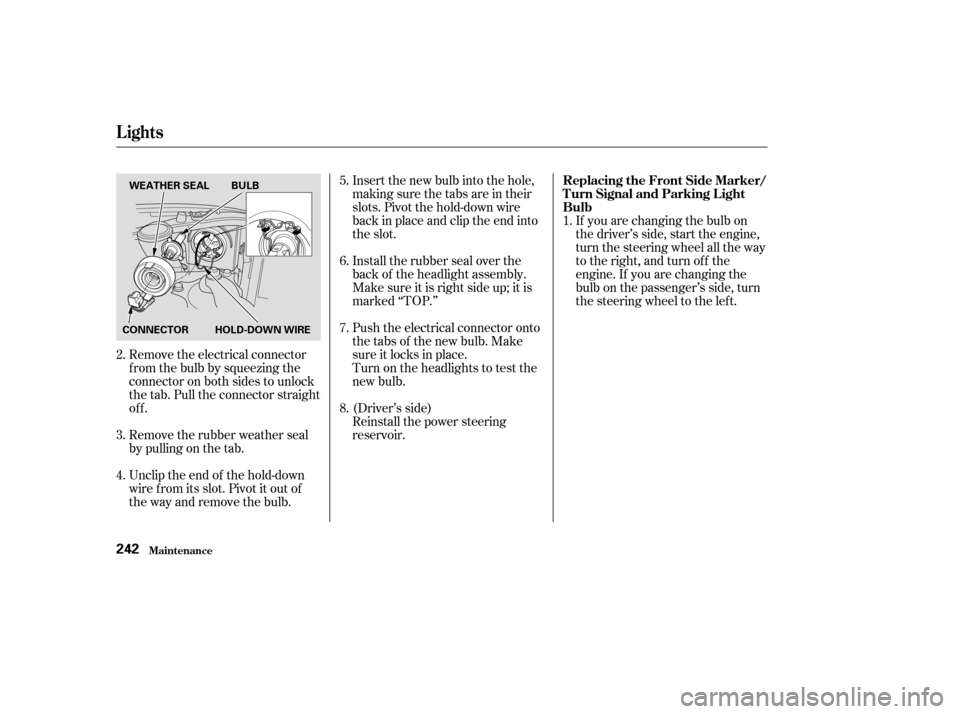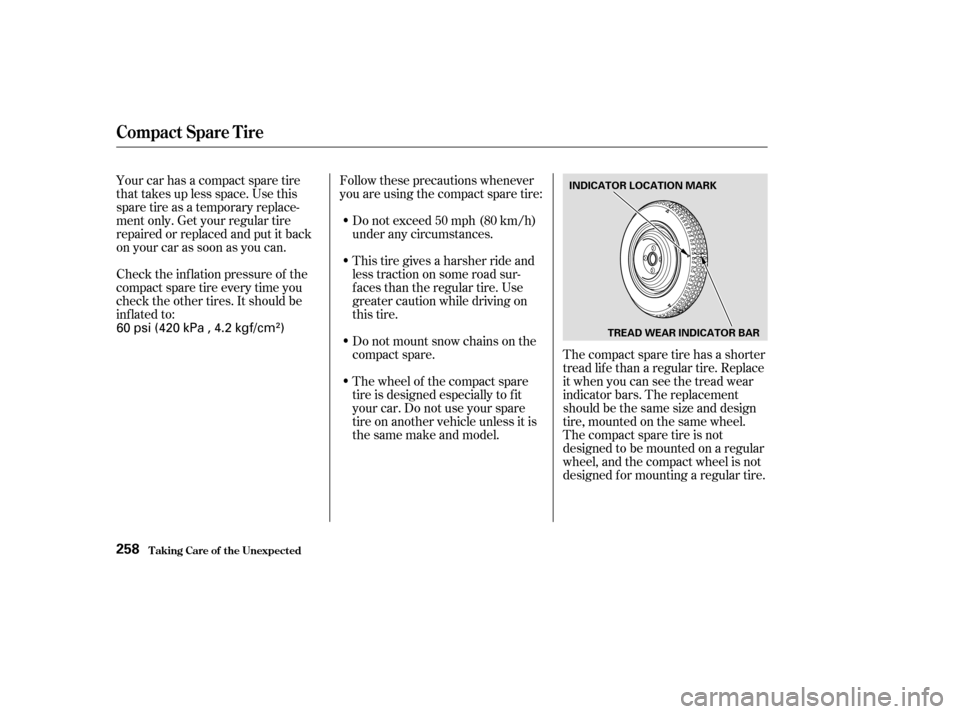Page 229 of 302

The tires that came with your car
were selected to match the perform-
ance capabilities of the car while
providing the best combination of
handling, ride comf ort, and long lif e.
Youshouldreplacethemwithradial
tires of the same size, load range,
speed rating, and maximum cold tire
pressure rating (as shown on the
tire’s sidewall). Mixing radial and
bias-ply tires on your car can reduce
its braking ability, traction, and
steering accuracy. It is best to replace all f our tires atthesametime.If thatisnotpossible
or necessary, then replace the two
f ront tires or the two rear tires as a
pair. Replacing just one tire can
seriously af f ect your car’s handling.TheABSworksbycomparingthe
speed of the wheels. When replacing
tires, use the same size originally
supplied with the car. Tire size and
construction can af f ect wheel speed
and may cause the system to work
inconsistently.
If you ever need to replace a wheel,
make sure the wheel’s specif ications
match those of the original wheel
that came on your car. Replacement
wheels are available at your Honda
dealer.
Replacing T ires and Wheels
Tires
Maint enance236
Installing improper tires on your
car can affect handling and
stability. This can cause a crash
in which you can be seriously
hurt or killed.
Always use the size and type of
tires recommended in this
owner’s manual.
�����—�����—�����y�
�����������
�y���
�(���%�������y���������y
Page 230 of 302

�´
Tires that are marked ‘‘M S’’ or
‘‘All Season’’ on the sidewall have an
all-weather tread design. They
should be suitable f or most winter
driving conditions. Tires without
these markings are designed f or
optimum traction in dry conditions.
They may not provide adequate
perf ormance in winter driving.
For the best perf ormance in snowy
or icy conditions, you should install
snow tires or tire chains. They may
be required by local laws under
certain conditions. If you mount snow tires on your
Honda, make sure they are radial
tires of the same size and load range
as the original tires. Mount snow
tiresonallfourwheelstobalance
your car’s handling in all weather
conditions. Keep in mind the traction
provided by snow tires on dry roads
may not be as high as your car’s
original equipment tires. You should
drive cautiously even when the roads
areclear.Checkwiththetiredealer
f or maximum speed recommenda-
tions.
Wheels:
See page f or inf ormation about
DOT Tire Quality Grading.
Tires:
(U.S.: HX)
(U.S.: DX, HX, LX, Canada: DX)
(U.S.: EX, Canada: LX, Si)
(U.S.: DX, LX, Canada: DX)
(Canada: LX)
(U.S.: EX, Canada: Si)
(Aluminum Wheel)
(Aluminum Wheel)
290
CONT INUED
Snow T iresWheels and Tires Winter Driving
Tires
Maint enance237
14x51/2JJ
P185/65R15 86H
P185/70R14 87S
14x51/2JJ
15x6JJ
15x6JJ
�����—�����—�����y�
�������������y���
�(���%�������y���������y
Page 231 of 302

Mount traction devices only when
required by driving conditions or
local laws. Make sure they are the
correct size f or your tires. Install
them only on the front tires.
Because your Honda has limited tire
clearance, mount only SAE Class ‘‘S’’
cable-type traction devices.
Metal link-type ‘‘chains’’ should not
be used. No matter how tight they
seem to be installed, they can come
into contact with the body and
suspension, causing serious damage.When installing traction devices,
f ollow the manuf acturer’s
instructions and mount them as
tightlyasyoucan.Driveslowlywith
them installed. If you hear them
coming in contact with the body or
chassis, stop and investigate. Make
sure the traction devices are
installed tightly, and that they are
not contacting the brakes or
suspension. Remove them as soon as
youstartdrivingonclearedroads.
Tires
Maint enance
T ract ion Devices
238
Cables that are the wrong size or
improperly installed can damage your
car’s brake lines, suspension, body, and
wheels. Stop driving if they are hitting
any part of the car.
�����—�����—�����y�
�����������
�y���
�(���%�������y�������
�y
Page 235 of 302

If you are changing the bulb on
the driver’s side, start the engine,
turn the steering wheel all the way
to the right, and turn off the
engine. If you are changing the
bulb on the passenger’s side, turn
the steering wheel to the left.
Reinstall the power steering
reservoir.
(Driver’s side)
Push the electrical connector onto
the tabs of the new bulb. Make
sure it locks in place.
Turn on the headlights to test the
new bulb.
Insert the new bulb into the hole,
making sure the tabs are in their
slots. Pivot the hold-down wire
back in place and clip the end into
the slot.
Install the rubber seal over the
back of the headlight assembly.
Make sure it is right side up; it is
marked ‘‘TOP.’’
Unclip the end of the hold-down
wire f rom its slot. Pivot it out of
the way and remove the bulb.
Remove the rubber weather seal
by pulling on the tab.
Remove the electrical connector
f rom the bulb by squeezing the
connector on both sides to unlock
the tab. Pull the connector straight
off.
3. 4. 5. 6. 7. 8.
1.
2. Replacing the Front Side Marker/
Turn Signal and Parking L ightBulb
Lights
Maint enance242
WEATHER SEAL BULB
CONNECTOR HOLD-DOWN WIRE
�����—�����—�����y�
�������������y���
�(���%�������y���������y
Page 241 of 302

Block the rear wheels.
Fill the f uel tank.
Change the engine oil and f ilter
(see page ).
Wash and dry the exterior
completely.
Cleantheinterior.Makesurethe
carpeting, floor mats, etc. are
completely dry.
Leave the parking brake off. Put
the transmission in Reverse
(5-speed manual) or Park
(automatic).
If you need to park your car f or an
extended period (more than one
month), there are several things you
should do to prepare it f or storage.
Proper preparation helps prevent
deterioration and makes it easier to
get your car back on the road. If
possible, store your car indoors.
If the car is to be stored for a
longer period, it should be
supported on jackstands so the
tires are of f the ground.
Leave one window open slightly (if
the car is being stored indoors).
Disconnect the battery.
Support the f ront wiper blade
arms with a f olded towel or rag so
they do not touch the windshield.
To minimize sticking, apply a
silicone spray lubricant to all door
and trunk seals. Also, apply a
vehiclebodywaxtothepainted
surfaces that mate with the door
and trunk seals.Coverthecarwitha‘‘breathable’’
cover, one made f rom a porous
material such as cotton.
Nonporous materials, such as
plastic sheeting, trap moisture,
which can damage the paint.
If possible, run the engine f or a
while periodically (pref erably once
amonth).
If you store your car f or 12 months
or longer, have your Honda dealer
perf orm the inspections called f or in
the 24 months maintenance schedule
(Normal Conditions) as soon as you
take it out of storage (see page ).
The replacements called f or in the
maintenance schedule are not
needed unless the car has actually
reached that time or mileage. 194
205
St oring Your Car
Maint enance248
�����—�����—�����y�
������
������y���
�(���%�������y�������
�y
Page 247 of 302

Two f actors normally contribute to
causing corrosion in your car:Moisture trapped in body cavities.
Dirtandroadsaltthatcollectsin
hollows on the underside of the
car stays damp, promoting
corrosion in that area.
Removal of paint and protective
coatings f rom the exterior and
underside of the car. Many corrosion-preventive measures
are built into your Honda. You can
help keep your car f rom corroding
by perf orming some simple periodic
maintenance:
Repair chips and scratches in the
paint as soon as you discover them.
Inspect and clean out the drain
holes in the bottom of the doors
and body.
Check the f loor coverings f or
dampness. Carpeting and f loor
mats may remain damp f or a long
time, especially in winter. This
dampness can eventually cause
the f loor panels to corrode. Use a high-pressure spray to clean
the underside of your car. This is
especially important in areas that
useroadsaltinwinter.Itisalsoa
good idea in humid climates and
areas subject to salt air. Cars
equipped with ABS have a sensor
and wiring at each wheel. Be
caref ul not to damage them.
Have the corrosion-preventive
coatings on the underside of your
car inspected and repaired
periodically.
1. 2.
Corrosion Prot ect ion
Appearance Care255
�����—�����—�����y�
�������������y���
�(���%�������y���������y
Page 249 of 302

Follow these precautions whenever
you are using the compact spare tire:Thecompactsparetirehasashorter
tread lif e than a regular tire. Replace
it when you can see the tread wear
indicator bars. The replacement
should be the same size and design
tire, mounted on the same wheel.
Thecompactsparetireisnot
designed to be mounted on a regular
wheel, and the compact wheel is not
designed f or mounting a regular tire.
Check the inf lation pressure of the
compact spare tire every time you
check the other tires. It should be
inf lated to:
Do not exceed 50 mph (80 km/h)
under any circumstances.
This tire gives a harsher ride and
less traction on some road sur-
f aces than the regular tire. Use
greater caution while driving on
this tire.
Do not mount snow chains on the
compact spare.
Your car has a compact spare tire
that takes up less space. Use this
sparetireasatemporaryreplace-
ment only. Get your regular tire
repaired or replaced and put it back
on your car as soon as you can.
The wheel of the compact spare
tire is designed especially to f it
your car. Do not use your spare
tire on another vehicle unless it is
thesamemakeandmodel.
Compact Spare Tire
T aking Care of t he Unexpect ed258
INDICATOR LOCATION MARK
TREAD WEAR INDICATOR BAR
60 psi (420 kPa , 4.2 kgf/cm)
�����—�����—�����y�
���������
���y���
�(���%�������y�������
�y
Page 251 of 302
Turn the jack’s end bracket
counterclockwise to loosen it, then
remove the jack.Loosen the f our wheel nuts 1/2
turn with the wheel wrench.
Find the jacking point nearest the
wheel you are removing. Place the
jack under the jacking point. Turn
the end bracket clockwise until
the top of the jack contacts the
jacking point. Make sure the
jacking point tab is resting in the
jack notch.
6.
7.8.
T aking Care of t he Unexpect ed
Changing a Flat T ire
260
JACK
WHEEL WRENCHJACKING POINTS
�����—�����—�����y�
�������������y���
�(���%�������y���������y